#Marine Science
Explore tagged Tumblr posts
Text
Skeleton Panda Sea Tunicate Appreciation Post!!! 💀 🐼 🌊



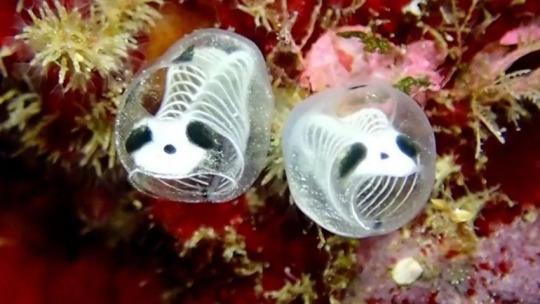


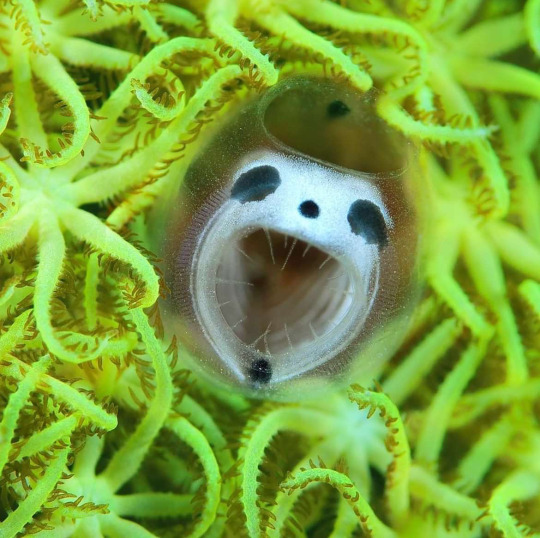
Clavelina ossipandae, the skeleton panda sea tunicate is a species of colonial ascidian, also known as sea tunicates, a group of sessile, marine filter-feeding invertebrates. Just some funky little guys!
First discovered near Kume Island in Japan by local divers, pictures of the animal attracted media attention in 2017. But they weren't given their formal taxonomic description until 2024
Love to sea it 🌊
#marine science#tunicates#science#biology#halloween#spooky season#skeleton#sea creatures#sea critters#marine creatures#marine life#photography#marine biology#sealife#ocean creatures#ocean#oceanposting#love to sea it#aquatic life#marine invertebrates#sea tunicate#chordata#invertebrates#sea life#sea animals#marine animals#ocean animals#ocean critters#fishblr#tunicate
8K notes
·
View notes
Text

FIRST-EVER FOOTAGE OF INDONESIAN COELACANTH IN NORTH MALUKU REVEALS NEW INSIGHTS INTO RARE SPECIES
The coelacanth, often dubbed a "living fossil," is one of the most iconic and mysterious marine vertebrates. Long thought extinct until its rediscovery in 1938, only two species are known today—Latimeria chalumnae in the western Indian Ocean, and L. menadoensis in Indonesia. The latter, the Sulawesi coelacanth, lives in deep, difficult-to-access reef habitats and has rarely been observed alive. For the first time, divers using advanced technical diving equipment have filmed a live Indonesian coelacanth in situ, at a depth of over 150 metres in North Maluku, a region where the species had not previously been recorded.

Left profile of the coelacanth, with its unique pattern of white dots. Photo by Alexis Chappuis.

- Localities from whence the Sulawesi Coelacanth, Latimeria menadoensis, has been reported in black stars. White star shows the North Maluku Province, where the first in situ sighting by technical divers was made.
This sighting is more than just a milestone in exploration—it provides critical data on the ecology and distribution of an animal that is evolutionarily unique and highly vulnerable. With few individuals ever seen in the wild, each observation adds valuable insight into how these ancient fish live and where they might still be found. It also underscores the urgency of protecting deep reef habitats that are increasingly at risk from human activities. Understanding and safeguarding the ecosystems that support the coelacanth is essential if we hope to ensure its survival into the future.
Main photo: Deep diver about a meter behind the coelacanth discovered at a depth of -144 m in North Maluku, Indonesia. Photo by Alexis Chappuis.
Reference (Open Access): Chappuis et al. 2025 First record of a living coelacanth from North Maluku, Indonesia. Sci Rep
4K notes
·
View notes
Text
Flight of the mini-mantas! These little devils are mobulas, which are cousins of the more famous manta ray. They are known to migrate together in enormous schools of hundreds or even tens of thousands of individuals (especially off of Baja California Sur), and have no spines like a stingray. As such they are completely harmless, and beautiful to watch underwater.
#mobula#ray#marine biology#marine bio#biology#zoology#animals#nature#ocean#marine science#ocean life#chondrichthyes#elasmos#elasmobranchs#marine ecology#marine conservation#conservation#fish
2K notes
·
View notes
Text
"If you're hoping that reef-restoring coral larvae will settle down in damaged reefs, you can't just sit around and wait for it to happen. You have to get out there and entice the larvae, which is exactly what a new algae-based gel is designed to do.
While we may think of coral reefs' "skeletons" as being composed solely of calcium carbonate produced by coral polyps, much of the material is in fact generated by what are known as crustose coralline algae.
Along with contributing greatly to the structural integrity of reefs, the algae-produced calcium carbonate also serves as a home to planktonic coral larvae. Once those formerly free-swimming organisms settle in and become polyps, they start producing reef-building calcium of their own.
It's a good arrangement for the coral, but it also benefits the algae.
Not only does the reef itself provide the algae with protection from the elements, the coral polyps also emit ammonia which the algae feed upon. It is therefore in the algae's best interest to entice any coral larvae that may be swimming past in the water column. In order to do so, the algae release metabolite chemicals that attract the larvae.
Led by Dr. Daniel Wangpraseurt, scientists at UC San Diego's Scripps Institution of Oceanography have now incorporated those metabolites into a gel that can be applied to degraded coral reefs. Called SNAP-X, the substance reportedly boosts coral larval settlement by up to 20 times as compared to untreated surfaces.
If the algae metabolites were just applied to the coral on their own, they would soon dissipate in the water, leaving the coral larvae unable to follow them to their source. For that reason, the researchers started by encasing the chemical molecules in durable silica nanoparticles. Those particles were then suspended within a biocompatible liquid blend of gelatin methacrylate and polyethylene glycol diacrylate.
When that liquid is sprayed or painted onto a surface – such as a piece of dead coral – then exposed to ultraviolet light, it polymerizes into a hydrogel form. That gel is capable of clinging to the surface for up to one month while immersed in flowing water, gradually releasing its larvae-attracting nanoparticles as it does so.
Initial lab tests showed that application of SNAP-X resulted in a six-fold increase in larval settlement. Subsequent tests that more accurately simulated the water flow on coral reefs, however, produced the 20-times figure.
It should be noted that all of the tests conducted so far have involved a single type of coral, but Wangpraseurt believes the technology should work on other species with a few tweaks.
"I think this material is a breakthrough that can hopefully make a big contribution to coral restoration," he says. "Biomedical scientists have spent a lot of time developing nanomaterials as drug carriers, and here we were able to apply some of that knowledge to marine restoration."
A paper on the research was recently published in the journal Trends in Biotechnology."
-via New Atlas, May 26, 2025
#coral#conservation#ocean#marine biology#ecosystem#ecosystem restoration#ecology#marine science#marine life#coral reef#science news#tidalpunk#biotechnology#good news#hope
1K notes
·
View notes
Text
Hi everyone - I am a marine researcher and I'm writing a paper about a fish and it's fishery local to where I live (New York). If you live in the US, and especially if you live in the coastal states between Maine and New Jersey, I would LOVE IT TREMENDOUSLY if you would answer my VERY SHORT survey here:
https://cornell.ca1.qualtrics.com/jfe/form/SV_d9VO97cruosRmjI
It should take *maybe* two minutes for you to do!
Thank you!!!
3K notes
·
View notes
Text
Pass the phone at sea edition
Meet our crew aboard MBARI's research vessel Rachel Carson as we explore the deep sea with the Monterey Bay Aquarium.
Science is a team activity, and we’re lucky to work alongside our education and conservation partner, @montereybayaquarium, to reveal the stunning diversity of life that thrives deep beneath the ocean’s surface.
From caring for deep-sea coral to driving a remotely operated vehicle (ROV), our team has a wide range of skills that make dives like these successful.
Follow along as we continue to share our journey at sea!
2K notes
·
View notes
Text
Join our Jellies team on a journey of gelatinous proportions! 🪼✨
youtube
Go behind the scenes as we reveal the science and skill behind culturing these delicate drifters from polyp to pulsing beauty. These brave biologists dive into the ocean’s darkness to observe a dazzling deep-sea migration. Blackwater dives give our Jellies team invaluable insights on how to replicate natural ocean conditions in our groundbreaking exhibits, bringing our guests face-to-face with fascinating fauna previously unseen outside the deep sea.


Monterey Bay Aquarium is a leader in jelly culturing–the science of raising an animal through its entire lifecycle. Doing this in-house means we have a sustainable population of these gelatinous beauties to inspire and educate our guests.
And outside our walls, our decades of research and innovations in jelly culturing led to exciting scientific breakthroughs and discoveries! 🔬🧬


Read on to learn about jelly culturing and how we bring the magic of the deep sea to you!
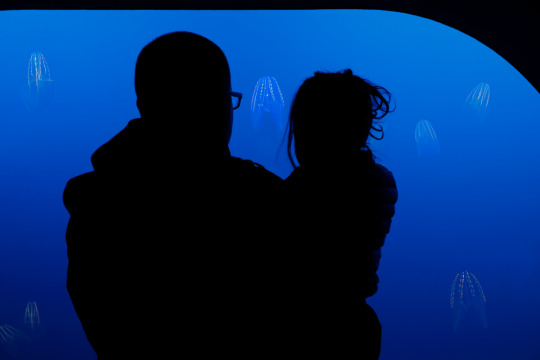
#monterey bay aquarium#comb jellies#marine science#aquariums#scuba diving#dont be jelly#just grow with the flow#beauty in biodiveristy#Youtube
329 notes
·
View notes
Text
If any of y'all are in DC, the NOAA could really use your help.

Reminder that the NOAA also houses the National Weather Service and tracks hurricanes.
Elon Musk is planning on reducing the NOAA by 50%. This is going to have horrendous consequences.
#NOAA#Donald Trump#elon musk#elongated muskrat#marine biology#marine science#biology#meteorology#environmentalism#hurricane helene#politics
373 notes
·
View notes
Text
If I ever made a kids TV show it would be called something like "big thing small thing" (very creative ik ik) but the general thing would go with the first part of the episode focusing on some big animal, like some kind of mammal, larger reptile etc, with fun facts and some stuff about conservation and where they live etc, and then tge next half would be exactly the same but about a niche species of snail or worm with all the exact fun facts and I'd have a special expert for both the animals to talk about it and there'd be fun cartoony sections too with the animals talking about the different ways they live and survive
#eddie in the ocean#i want to go into public science communication or something can you tell its definitely not obvious or anything#science#marine science#biology#zoology#ecology
511 notes
·
View notes
Text

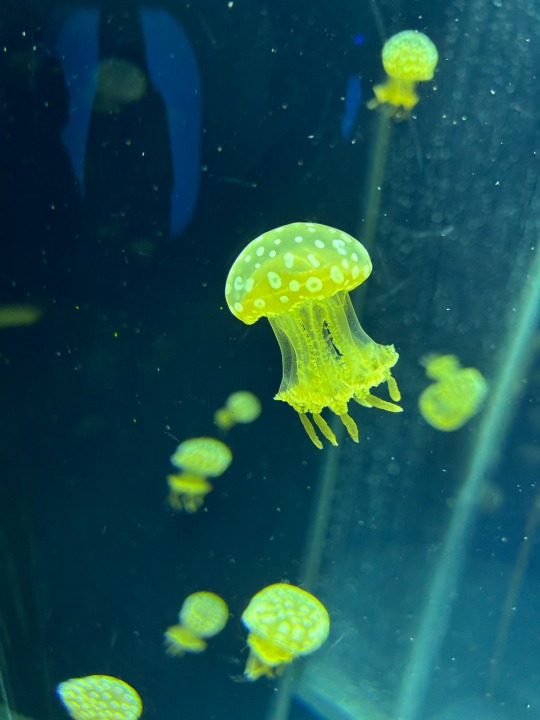
spotted lagoon jelly
picture by @underlyingocean
2K notes
·
View notes
Text
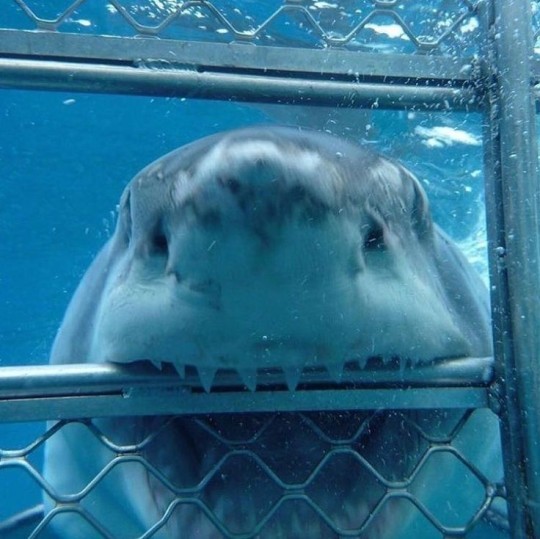
Idk seems friendly enough
3K notes
·
View notes
Text


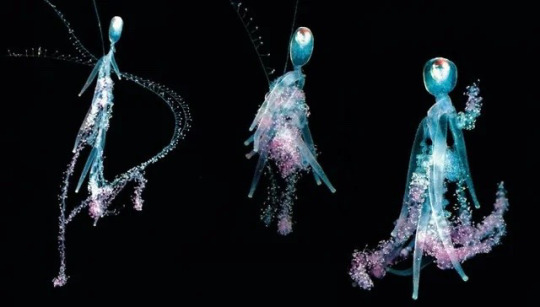


Rhizophysa filiformis // No common name
Rhizophysidae is a family of siphonophores in the suborder Cystonectae. Look at them go 💚🩵💜
Love to sea it 🌊
#Rhizophysa#Rhizophysidae#marine creatures#marine biology#science#marine life#marine science#love to sea it#cnidarians#cnidarian#siphonophore#siphonophores#hydrozoan#ocean life#ocean animals#sea life#sea creatures#deep sea#fishblr#aquatic life#marine animals#sealife#sea critters#ocean creatures#ocean critters#sea animals#hydrozoans
8K notes
·
View notes
Text
TWO INJURED SEA COMBS CAN FUSE INTO A SINGLE ENTITY, AND THRIVE
In a surprising new discovery, scientists have found that two injured individuals of Mnemiopsis leidyi, a species of comb jellies or ctenophores, can fuse into a single entity. This phenomenon, which challenges our typical understanding of biological processes, reveals just how remarkable these planktonic creatures truly are.
Ctenophores, known for their translucent beauty and delicate movement in the ocean, appear to lack a mechanism called allorecognition—the ability to distinguish between self and non-self. This means that, when two comb jellies are injured and placed close together, they can merge, not just physically, but also functionally. Their nervous systems combine, allowing them to share nerve signals (or action potentials), and even their digestive systems become one.
The discovery was made by Dr. Jokura and his team, who were observing comb jellies in a seawater tank. After removing parts of their lobes and placing them side by side, they were astonished to see 9 out of 10 injured comb jellies fuse to form a single organism. Even more fascinating, the newly formed organism survived for at least three weeks, with its muscle contractions fully synchronized within just two hours. The digestive system also fused, enabling food taken in by one mouth to travel through their shared canal and exit through both anuses—although not at the same time!
While the exact benefits of this fusion are still unclear, the researchers believe that studying this phenomenon could provide valuable insights into how organisms integrate nervous systems and even how tissue regeneration occurs. It may also offer clues about immune system functions in species where the lines between individual organisms become blurred.
This discovery offers a glimpse into the hidden potential of the ocean’s lesser-known inhabitants, challenging what we think we know about biological boundaries and cooperation.
Video: Kei Jokura
Reference: Jakura et al., 2024. Rapid physiological integration of fused ctenophores. Current Biology
#Mnemiopsis leidyi#what?#ctenophora#combjellie#science#marine science#biology#marine biology#sciblr#scienceblr
1K notes
·
View notes
Text
While on a shark dive, it is important to respect their space as they are wild animals. That said, these nurses were definitely seeking out interaction, and the divemaster had a safe, touch-free compromise at the ready!
#sharks#nurse shark#marine biology#marine bio#biology#zoology#animals#nature#ocean#cute animals#marine science#elasmobranchs#shark diving#scuba#scuba diving#marine conservation#ecology
2K notes
·
View notes
Text
"Many people know about the Yellowstone wolf miracle. After wolves were reintroduced to the national park in the mid-1990s, streamside bushes that had been grazed to stubble by out-of-control elk populations started bouncing back. Streambank erosion decreased. Creatures such as songbirds that favor greenery along creeks returned. Nearby aspens flourished.
While there is debate about how much of this stemmed from the wolves shrinking the elk population and how much was a subtle shift in elk behavior, the overall change was dramatic. People were captivated by the idea that a single charismatic predator’s return could ripple through an entire ecosystem. The result was trumpeted in publications such as National Geographic.
But have you heard about the sea otters and the salt marshes? Probably not.
It turns out these sleek coastal mammals, hunted nearly to extinction for their plush pelts, can play a wolf-like role in rapidly disappearing salt marshes, according to new research. The findings highlight the transformative power of a top predator, and the potential ecosystem benefits from their return.
“It begs the question: In how many other ecosystems worldwide could the reintroduction of a former top predator yield similar benefits?” said Brian Silliman, a Duke University ecologist involved in the research.
The work focused on Elk Slough, a tidal estuary at the edge of California’s Monterey Bay. The salt marsh lining the slough’s banks has been shrinking for decades. Between 1956 and 2003, the area lost 50% of its salt marshes.
Such tidal marshes are critical to keeping shorelines from eroding into the sea, and they are in decline around the world. The damage is often blamed on a combination of human’s altering coastal water flows, rising seas and nutrient pollution that weakens the roots of marsh plants.
But in Elk Slough, a return of sea otters hinted that their earlier disappearance might have been a factor as well. As many as 300,000 sea otters once swam in the coastal waters of western North America, from Baja California north to the Aleutian Islands. But a fur trade begun by Europeans in the 1700s nearly wiped out the animals, reducing their numbers to just a few thousand by the early 1900s. Southern sea otters, which lived on the California coast, were thought to be extinct until a handful were found in the early 1900s.
In the late 1900s, conservation organizations and government agencies embarked on an effort to revive the southern sea otters, which remain protected under the Endangered Species Act. In Monterey Bay, the Monterey Bay Aquarium selected Elk Slough as a prime place to release orphaned young sea otters taken in by the aquarium.
As the otter numbers grew, the dynamics within the salt marsh changed. Between 2008 and 2018, erosion of tidal creeks in the estuary fell by around 70% as otter numbers recovered from just 11 animals to nearly 120 following a population crash tied to an intense El Niño climate cycle.
While suggestive, those results are hardly bulletproof evidence of a link between otters and erosion. Nor does it explain how that might work.
To get a more detailed picture, the researchers visited 5 small tidal creeks feeding into the main slough. At each one, they enclosed some of the marsh with fencing to keep out otters, while other spots were left open. Over three years, they monitored the diverging fates of the different patches.
The results showed that otter presence made a dramatic difference in the condition of the marsh. They also helped illuminate why this was happening. It comes down to the otters’ appetite for small burrowing crabs that live in the marsh.
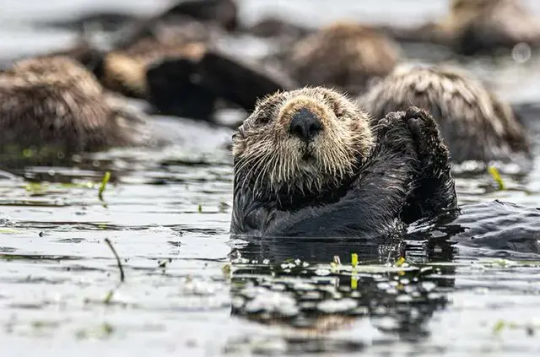
Adult otters need to eat around 25% of their body weight every day to endure the cold Pacific Ocean waters, the equivalent of 20 to 25 pounds. And crabs are one of their favorite meals. After three years, crab densities were 68% higher in fenced areas beyond the reach of otters. The number of crab burrows was also higher. At the same time, marsh grasses inside the fences fared worse, with 48% less mass of leaves and stems and 15% less root mass, a critical feature for capturing sediment that could otherwise wash away, the scientists reported in late January in Nature.
The results point to the crabs as a culprit in the decline of the marshes, as they excavate their holes and feed on the plant roots. It also shows the returning otters’ potential as a marsh savior, even in the face of rising sea levels and continued pollution. In tidal creeks with high numbers of otters, creek erosion was just 5 centimeters per year, 69% lower than in creeks with fewer otters and a far cry from earlier erosion of as much as 30 centimeters per year.
“The return of the sea otters didn’t reverse the losses, but it did slow them to a point that these systems could restabilize despite all the other pressures they are subject to,” said Brent Hughes, a biology professor at Sonoma State University and former postdoctoral researcher in Silliman’s Duke lab.
The findings raise the question of whether other coastal ecosystems might benefit from a return of top predators. The scientists note that a number of these places were once filled with such toothy creatures as bears, crocodiles, sharks, wolves, lions and dolphins. Sea otters are still largely absent along much of the West Coast.
As people wrestle to hold back the seas and revive their ailing coasts, a predator revival could offer relatively cheap and effective assistance. “It would cost millions of dollars for humans to rebuild these creek banks and restore these marshes,” Silliman said of Elk Slough. “The sea otters are stabilizing them for free in exchange for an all-you-can-eat crab feast.”"
-via Anthropocene Magazine, February 7, 2024
#otters#sea otters#conservation#erosion#coastal erosion#coastline#marshes#saltwater#marine science#marine biology#marine animals#sea creatures#ocean#sustainability#soil erosion#erosion control#crab#good news#hope
3K notes
·
View notes
Text

Marine scientist au Chase n House based off that one screenshot from tiktok
462 notes
·
View notes